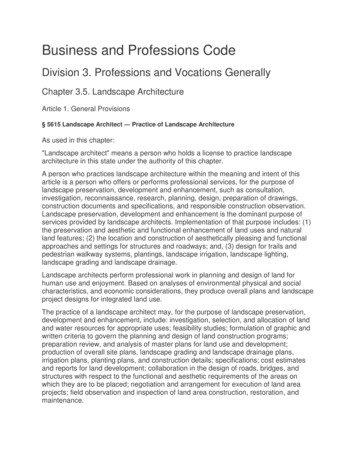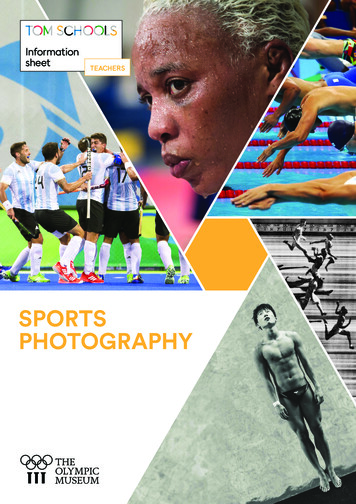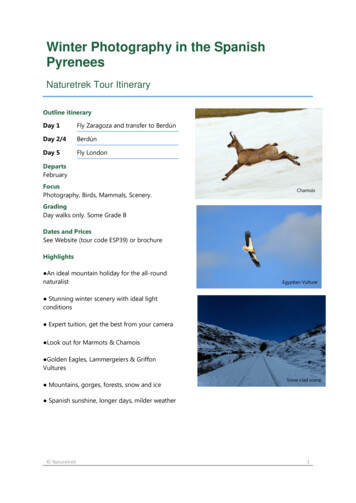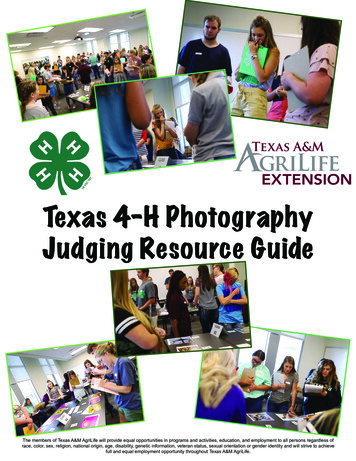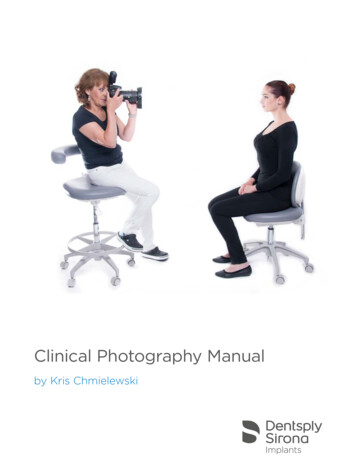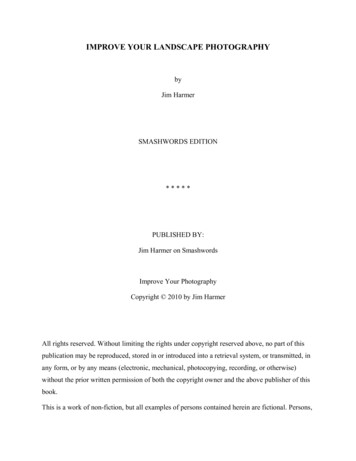
Transcription
IMPROVE YOUR LANDSCAPE PHOTOGRAPHYbyJim HarmerSMASHWORDS EDITION*****PUBLISHED BY:Jim Harmer on SmashwordsImprove Your PhotographyCopyright 2010 by Jim HarmerAll rights reserved. Without limiting the rights under copyright reserved above, no part of thispublication may be reproduced, stored in or introduced into a retrieval system, or transmitted, inany form, or by any means (electronic, mechanical, photocopying, recording, or otherwise)without the prior written permission of both the copyright owner and the above publisher of thisbook.This is a work of non-fiction, but all examples of persons contained herein are fictional. Persons,
places, brands, media, and incidents are either the product of the author's imagination or are usedfictitiously. The trademarked and/or copyrighted status and trademark and/or copyright ownersof various products referenced in this work of fiction, which have been used without permission,is acknowledged. The publication/use of these trademarks and/or copyrights isn’t authorized,associated, or sponsored by the owners.Smashwords Edition License NotesThis eBook is licensed for your personal enjoyment only. This eBook may not be re-sold orgiven away to other people. If you would like to share this book with another person, pleasepurchase an additional copy for each person you share it with. If you're reading this book and didnot purchase it, or it was not purchased for your use only, then you should return toSmashwords.com and purchase your own copy. Thank you for respecting the author's work.*****Chapter Zero: Author’s Introduction
When a photographer shoots for enough years, she will inevitably end up specializing in one typeof photography. The same is true with me. When I think of photography, I think of landscapes.Nothing can compare to the experience of waking up at 4AM, driving to a location, and watchingnature as the sunrise wakes up the Earth.As you capture life at 1/100th of a second, don’t forget the Creator of the beautiful landscapesyou record.Regards,Jim Harmer*****Chapter One: What You Didn’t Already Know About CompositionComposition is the placement of objects or space within a photograph. The goal of compositionin photography is to tie together each element within the frame to create one cohesive scene.Composition is probably the second most important element of great photography--second only
to lighting. The good news is that composition is not difficult to learn.What You Already Know: The Rule of ThirdsAnyone who calls herself a photographer knows the rule of thirds. Picture a tic-tac-toe board onyour image rectangle. If you put the focal point of your image on one of the intersections of thelines, you’ll have good composition. Having the subject of the photo off-center createsinteresting visual space and makes the eye view the image as a whole. Next time you turn on theTV, notice how often the camera men follow the rule of thirds. Actors or objects which are thesubject of the video are often placed on one of those intersections of third lines to create visualinterest. Simply following the rule of thirds will instantly make your photographs better than95% of beginning photographers.
What You Didn’t Know About the Rule of ThirdsUnfortunately, most photographers learn the rule of thirds and never learn any advancedcomposition techniques. The unfortunate truth about the rule of thirds is that it is not the rule ofcomposition that should be followed. The rule of thirds is merely the Cliff’s Notes version ofcomposition. The rule of thirds is simply an easy way to explain the real rule of composition thatadvanced photographers have used for centuries. That rule, is Fibonacci’s Ratio.Fibonacci’s WHAT?!?!? Let me explain First of all, photographers most commonly refer toFibonacci’s ratio as the “golden mean.” I only used the words “Fibonacci’s Ratio” because itsounds more impressive. Either way, Fibonacci’s Ratio, or the golden mean, is the best way toproportionately place objects within the frame of a photograph.The golden mean is similar to the rule of thirds, but varies the spacing between the lines. Lookat the image above. Instead of the three horizontal and vertical sections being perfectly equal,the first section is given 1 unit of spacing from the edge of the photo on both the horizontal andvertical axis. The third section is likewise given 1 unit of spacing from the edge of the photo.The middle horizontal and vertical section, however, is squished. It is only given approximately0.62 units of spacing. The squishing of the middle section brings the main focal point of theimage (which is still placed on one of the line intersections) closer toward the middle.While the golden mean may seem to be only a slight variation of the rule of thirds, the truth is
that the opposite is true. The rule of thirds is only a slight variation on the golden mean. Thegolden mean is nearly as old as art itself.If this subject intrigues you and you want to understand it further, be prepared to read conspiracytheories, hidden mathematical formulas in world-famous paintings, and lots of complex math.The information in this chapter is the need-to-know information on a very complex subject towhich there is no limit on the amount of material available.Suffice it to say in this cursory review of the topic that the rule of thirds is technically incorrectand better proportionality can be achieved in your photography if, when you put the viewfinderup to your eye, you picture the rule of thirds with a “squished” (smaller) middle section. Youcan see this for yourself by looking at the diagrams on the two images above to illustrate thedifference between the golden mean and the rule of thirds. Notice that the placement of the manwith the umbrella in the field is more natural in the composition illustrating the golden meanbecause the man is not quite so shoved over into the corner of the image. While still off-center,he feels more naturally placed somewhat closer to the center area of the photo. The rule of thirdscomposition is perfectly acceptable, but most people prefer the composition following the goldenmean.Following the golden mean rather than the rule of thirds will result in stronger compositions thatcontain the subject in the frame with better proportionality. In short, the image will feel morebalanced than if the strict rule of thirds is used. When I first learned of the golden mean sometime ago, I was skeptical at first. Then, I looked through my portfolio of my all-time bestimages. Sure enough! A large percentage of the images were closer to the golden mean than therule of thirds. Since that time, I have fully adopted the golden mean as my primary rule ofcomposition, and use the rule of thirds as an afterthought.
Foreground, Mid-Ground, BackgroundI recently looked for a good Creative Commons image of lightning on Flickr to use with anarticle I was writing for a photography publication. After 30 minutes of searching, I gave uphope. I looked through hundreds of pictures of lightning storms, but they all had the sameproblem.Beginning photographers fail to understand that subject should never overcome lighting orcomposition. No matter how incredible a landscape is, the image will never look professionalwithout good lighting and composition. This was the problem with the lightning photos.All of the images I saw were a black abyss of a landscape with awesome bolts of lightning far inthe background. The photographers apparently thought that since they had an incredible subjectto photograph (the lightning), they could forget about composition.So what would have made these plain and average photos a masterpiece? As the sub-chaptertitle suggests: foreground, mid-ground, background.Almost every landscape photo looks better when the photographer incorporates something as aninteresting foreground subject—a rock, a tree, a stream, a puddle, anything. Then, the midground of the photo should be clear and distinct in order to make the viewer of the photographfeel drawn into the picture. Last, the photo needs an interesting background such as mountains,
lightning, clouds, or whatever else. Photos are 2D but humans see 3d. Applying this techniquein your photography will draw the viewer into the scene and give the 2 dimensional image afeeling of depth.This idea might sound good in theory, but how can you apply this rule in the field? When yougo to take a shot of a beautiful scene, find something to put close to the camera and somethingfar in the distance. When you’re photographing a waterfall, consider putting something near thecamera: a flower, an interesting rock, a tree, etc. Then the photograph will have that foregroundelement, the ground leading to the waterfall as a mid-ground element, and the waterfall as abackground element. Remember that when you do this, you’ll have to use a high aperture(somewhere between f/11 and f/22) so that both the foreground elements and the background arein sharp focus.This rule is not a substitute for the golden mean. In fact, this builds upon the golden mean. Theforeground element is usually placed in the lower-left or lower-right third of the frame in order tocreate visual interest. For example, suppose you are photographing beautiful fall-colored treessurrounding a small pond. You have chosen to place a bright red leaf in the water just in front ofyou as a foreground element, the water of the pond will be the mid-ground element, and then thetrees and sky will serve as background elements. Where should the bright leaf in the foregroundbe placed? You already know the answer. It should be placed a few feet in front of the cameraoff to the side of center. It will be placed according to the golden mean. In this example, thecomposition follows both the golden mean and foreground, mid-ground, and background.Perfect composition.If your landscape photography is guilty of ignoring composition, remember the most importantelement of landscape composition—foreground, mid-ground, background.
Leading LinesGreat photographs give the viewer’s eye somewhere to go. A leading line, such as a bridge, road,tree line, or shore line, will bring the viewer from the edge of the photograph into the middle andbackground. This immediately adds depth to a flat image and makes the viewer feel like she isstanding where you took the shot. In a way, a leading line acts as a foreground element becauseit is near the camera and draws the viewer’s eye into the depth of the scene.Remember that leading lines should follow usually follow the golden mean. Suppose you areshooting a landscape where there is thick vegetation with a dirt hiking trail going through theforest. The path should come from the bottom left or bottom right of the scene where the goldenmean lines touch the edge of the photo. This will add balance to the lines.When leading lines are used, it is also common to intentionally break the golden mean andsimply shoot from on the trail with the path leading straight out into the distance. This can also
be an effective technique when used correctly. Generally, this intentional violation of the rulesof composition works well with a straight leading line. If the path goes on for a long distancewithout winding, it might be a good time to use this technique; however, if there are bends in thepath, it probably will not work well in the center of the image.*****Quick and Random Tip to Improve Your Compositions!Look at the image later in the book immediately preceding the chapter on taking landscapephotos while liking. Notice how the rock arch is used to frame the composition. This is a terrificway to include part of the natural scene, focus the viewer’s attention on the center subject of thephoto, and follow the foreground, mid-ground, background rule. Anything could be used toframe the subject of a landscape picture. It may be two trees on either side of the image, or youmight shoot through the window in a cabin, your anything else that you can imagine. If you haveheard this tip before but have never actually tried it, make it your goal to implement thispowerful composition in your next shoot.*****
Chapter Two: Taking the Iconic ImageI live in a popular vacation destination in southwest Florida. Millions of photos are taken everyyear in this city by photographers from all around the world. Because of this, many of the localstudents in my photography classes ask where they can go to shoot photography because all ofthe tourist locations have already been photographed millions of times.You probably have the same problem in your city. Perhaps the old school house is a beautifullocation for photography, but it has already been shot to the point of becoming cliché. Orperhaps you are going on vacation to New York City, or the Grand Canyon, or Yellowstone andwant to capture unique images of the popular sites. Now what?Making Old Locations Look NewIn my city, the most photographed location is the Naples Fishing Pier on the beach near thedowntown area. I have seen hundreds of beautiful images of the location but they all look thesame. They are all taken at sunset from the same angle with the same composition. It would bedifficult not to get a good image from this spot because the scene is so beautiful, but is therereally no way to capture a creative and unique view of this landmark?I wanted to capture images of the pier that people hadn’t already seen. I did three things to makethe same old location look new. Follow these three steps and you’re sure to capture a never
before seen image of the popular photography location near your home, too.First, I searched for a new angle. Everyone shoots the pier from approximately 50 feet to theside of it so that the whole pier can be seen in one shot. So, I walked straight under the pier nearthe supports that lift it out of the water. This was the least likely place to take a landscape imageof the pier, so I knew it would be perfect. You can apply this principle no matter what commonlandscape location you’re attempting to conquer. If there is a beautiful courthouse in the centerof your town, shoot from among the columns in the entry rather than the shot from across thestreet that everyone captures. If the common image of the lake is most commonly taken from thewater’s edge, consider climbing a nearby hill or tree to shoot from a higher angle. Whatever youdo, remember that the first rule to making old locations look new is to find a fresh angle fromwhich to shoot the image.The second rule is to capture the location in a new light—literally. In my situation of shootingthe pier, this meant I would have to shoot the landscape at a time other than sunset. Sunset wasthe lighting that every photographer used. So, I chose to wait for an exceptionally cold day (InFlorida, “cold” weather means below 60 degrees Fahrenheit). This colder weather produced abeautiful fog over the water and created a gorgeous mood for my image. The fog caught thelight in a spectacularly new way and gave the old scene a new look.The third and last rule is to intentionally cut off part of the scene. My viewpoint from under thepier (remember rule number 1?) obviously only allowed me to see the supports under the pierand the underside of the deck of the pier. I couldn’t see anything else. I chose to only show partof the pier in my image to highlight a part of the pier. The pier supports have barnacles, moss,and rust all over them. To me, this rustic look on the pier’s supports was beautiful and visuallyappealing. Most people never take a second glance at this part of the pier, so I knew byhighlighting this part, it would look like a new location.
Finding the Lesser-Known Landscape LocationsThe key to finding lesser-known photography locations is to force yourself to try new things.When shooting in a city or area that is new to me, I start my research on flicr.com. Flickr is theworld’s largest photo-sharing website. On the site, you can search by location or view geotaggedimages. I use Flickr to decide where I am not going to go. If there are 100 images on Flickr ofEagle Lake, then choose to leave that location alone and try something new. Once you haveruled out the over-photographed areas (or you shot the over-photographed areas using the tips inthe previous sub-chapter), you need to find somewhere new.For this, I usually start by looking at a map of the area, Geocaching locations, and hikingwebsites. I’ll address each of these options individually.First, a map of the area. Google maps offer incredible data about every city in the world. First,zoom out and see the city from afar. Do you want to shoot cityscapes? Then decide what is the
most industrialized area of the city. Would you like to shoot at a lake or a more natural location?Then look for forested areas and parks. Google Maps allows you to use the satellite view as wellas street view to hone in on the best areas. Now you know the general area where you may wantto shoot.The map option will likely be a work of trial and error. You may find a location that looksinteresting on a map, but you later discover to be rather dull; however, working locations withjust a map can often lead you to many unknown locations for shooting landscape photography.The second tip is to look at Geocaching locations. Geocaching is a hobby for people who ownGPS units. Geocaching is when people get a box, put something in it (such as an old coin,something funny, or even just a piece of paper for people to sign), hide or bury the box with theprize in it, and then the person gets the GPS coordinates for the location where the prize ishidden and posts the coordinates online. Then, other geocachers can go to the location andsearch for the treasure. Whoever finds the geocache replaces the old prize with a new prize.What does this have to do with landscape photography? Everything. If you have a GPS unit(including your smartphone, car GPS, or a handheld GPS unit), create a login on a geocachingwebsite, search your city, write down the coordinates, and go to these locations for landscapephotography! Almost without exception, these end up being beautiful places. Geocachers takepride in finding the hidden gems in a city and bringing other people to those beautiful little spotsby guiding them to a hidden treasure. Also, geocaches are almost always placed in publiclyaccessible locations, so you know you’ll be able to shoot from the spot. This is, perhaps, themost fun way to find new locations and you’ll probably discover places in your city that you’venever given a second thought to.The last idea is to search hiking websites. Hikers, like geocachers, usually want to find sceniclocations to practice their hobby. Search for public hiking trails and read the comments of hikersas they will usually mention things like what the best time of year is to hike on the trail, what canbe seen while hiking, dangers, how rigorous the hike is, etc. Hiking websites are a great resourceto landscape photographers.*****
Chapter Three: Special Issues in Shooting in Cold WeatherIf you live in Florida like I currently do, feel free to take a nap until the next chapter; however,cold weather and snow are situations in which photographers need to change their techniquesdrastically to achieve useable results.Shooting in cold conditions can damage cameras and lenses if care is not taken. If taking acamera from the cold weather into a warm car or house, the lens will experience significantcondensation. This condensation may be slight and only fog up the front of the lens, or it can besevere and introduce water into the inner workings of the camera or lens. In either case,preparing beforehand can prevent these problems. Simply bring a large grocery sack or freezerbag to put the camera and equipment in when transporting the gear into or out of a warm area.This will make the condensation form on the outside of the bag and protect the camera.If you frequently change from warm to cold and back to warm when shooting, considerpurchasing a cheap rain sleeve for your camera so it can stay on the camera the whole time andprevent the condensation from forming. Then put the lens cap on the front of the lens and youare prepared for cold conditions.Condensation is not the only battle for photographers when shooting in the cold. Autofocus
doesn’t work correctly in the snow because the autofocus picks up the falling snow and tries tofocus on it. Consequently, you’ll need to focus manually. This also holds true for flash. If youuse flash in the snow, the light will catch the closest snowflakes and make them look likeblindingly-white blobs and the rest of the snow will look dark and grey. Flash is a no-go in snow.Exposure is the biggest concern for shooting in the snow. When you press the shutter buttonhalf-way down, the camera attempts to find the correct exposure before the shutter is opened.When the camera sees too much white in the image it thinks the image is brighter than it is, so itover-compensates. This results in dark muddy-looking snow. How do you fix this? If shutterpriority or aperture priority is selected, positive exposure compensation can be used to remedythe dark snow. Turn your exposure compensation to about 1 (over exposed by one stop oflight) and you’ll get cleaner images.Shooting in the snow can give average landscapes a beautiful look and feel. Colors really “pop”(that word is my pet-peeve) when placed on a beautiful snowy background. Notice in the imageabove that the tan grass at the bottom is a vibrant where it would probably look quite dullwithout the white background. Look for scenes to shoot in the snow that might not otherwisemerit attention.The last, and one of the most important, considerations for shooting in the snow is white balance.DSLR cameras calibrate colors based on what it deems to be white in a particular lightingsituation. While our eyes have no difficulty in determining what is white under varying lightingconditions, cameras are not as adept at making this calculation. Take special care when takingpictures and editing the images that the white balance is set correctly or you will have a blue oryellow color cast to the image.*****
Chapter Four: The Easiest Way to Capture Landscapes that Convey a MoodPhotographers who take my in-person photography classes often ask how to give their photosmore impact and punch. Too often, beginning landscape photographers have portfolios that lookmore like postcards than jaw-dropping landscape images. When I see this problem, I usually tellthe photographer to choose her 10 best landscape photos. I ask the student to go back to thosesame 10 locations (where feasible), and shoot the exact same photo at night rather than in thelight it was originally shot in. This exercise transforms the “postcard” shots from before intomoody landscape photos that actually convey an emotion to the viewer. This is the essence oflandscape photography capturing a scene in such an impactful way that it affects the mood ofthe viewer.Undoubtedly, the same impact and mood captured in night images can also be captured duringthe day, but this takes practice and skill. By shooting landscapes at night, the photographer willbegin to catch on to what kind of photography they can eventually capture if they put the workinto it.I already know what will happen if you take this challenge to re-shoot your best 10 images atnight. Your images will have mood, but they will also have noise. Digital noise is a grainyeffect on images. The effect is caused by stray electric signals being captured by the photosites
on the camera sensor and interpreted as light in the scene and consequently reflected on theimage.To make beautiful landscape images at night, photographers must first learn how to overcomenoise. The three main factors that control how much noise is in an image is the quality of thecamera, the ISO, and the shutter speed.The fact is that some cameras perform better in low-light than others. Each generation of cameraperforms slightly better than the previous generation, and some camera manufacturers do betterthan others. This factor is only briefly mentioned to call to your attention the importance of lowlight performance when picking a new camera. This is the very first spec I look at whenchoosing a camera.The second factor is shutter speed. As previously mentioned, digital noise is caused by strayelectric signals on the camera sensor. When a long shutter speed is used, the camera sensor mustcontinually record the scene for a longer period of time. Therefore, more electric signals arecaptured.The third main contributor to noise is also the most important: ISO. ISO controls how sensitivethe camera is to light. Think of ISO like an audio cassette player. If the listener has a hard timeunderstanding the voice on the audio cassette, the listener will turn up the volume. This makesthe speakers more sensitive to the information on the cassette. By doing so, the voice becomeslouder, but there is also an added fuzz sound in the background. ISO works similarly. It makesthe camera more sensitive to light when it is turned up, but it also adds fuzzy grain to the image.At this point, photographers always ask the same question, and it goes something like this: ifshutter speed and ISO both add to the amount of noise, should I choose an ISO of 400 and a 10second exposure, or should I choose an ISO of 200 and a 20 second exposure? Both of thesecombinations will gather the same amount of light, but which one will produce less noise?Unfortunately, it is not possible to answer this question generally, because it is camera specific.In general, newer and higher-quality images would produce less noise with the 400 ISO and 10second shutter speed, and older or lower-quality DSLRs would do better with the othercombination. I raise this point to call your attention to the need to learn your camera and how itreacts in these situations.
Aside from choosing the correct ISO and shutter speed, other settings on the camera can aid thephotographer in achieving noise-free and sharp images at night.Most DSLRs have a setting called long-exposure noise reduction. This setting is in the customfunctions of Canon cameras. To get there, click the menu button on the back of your DSLRabove the LCD, then use your right arrow key to go over to the option for custom functions andselect it. Then use your right arrow key to browse through the functions until you see longexposure noise reduction and enable it. This setting makes your camera go through a process toreduce the noise in longer exposures. By enabling this setting, the camera will always applylong-exposure noise reduction when a long shutter speed is used, but will not affect shorterexposures.Cameras have several methods of reducing noise at long shutter speeds, but the most common iscalled “Dark Frame Subtraction.” In this method, the camera takes the exposure and then takesanother exposure (which the photographer never sees) with the shutter closed. The cameradetects which pixels are hot and where leakage occurs and then subtracts those deficiencies fromthe proper exposure taken by the photographer. This method is very effective in reducing noisein long exposures, but it takes twice as long.Many photographers who use long-exposure noise-reduction become surprised when the cameratakes a near eternity to write the image to the card. The reason is that during this time, thecamera is taking the second exposure with the shutter closed. After the second image is taken,the camera subtracts the hot pixels from the normal exposure and then applies this information tothe RAW file or the JPEG.You need to change one more setting in the custom functions before leaving. This one isn’t quiteas important, but still adds a small advantage. Your DSLR has a mirror which allows thephotographer to use the viewfinder to look through the lens. The mirror which reflects this viewflips up very quickly while the image is being recorded (which is why the viewfindermomentarily goes black when you press the shutter button). This mirror movement vibrates thecamera just slightly, but that’s enough to make your long exposure look a bit blurry sometimes.To fix this, enable mirror-lockup. When you press the shutter the first time, it will lock themirror and then when you press the shutter the second time, it will take the image. This is NOT asetting you want turned on all of the time as it quite annoying, but it’s a valuable setting for night
photographers.When taking long exposures at night, the camera must be absolutely locked down on the tripodso it won’t vibrate at all. Any vibration while taking the image will be noticeable. Since manybudding photographers haven’t yet invested in a professional tripod, you need to be especiallycareful. Even if your camera is on a tripod, if the wind blows the camera strap around, it canvibrate the camera just enough to show up in the image. Take the camera strap off or wrap ittightly around the tripod so it can’t blow.If you’ve ever shot a gun before, you know how important it is not to jerk the trigger. Even aslight bump of the firearm while the trigger is being squeezed can set a bullet far off course whenit travels downrange. Photography is not very different. No matter how still you hold, if yousmack the shutter button when you’re ready to shoot, you’ll have a blurry image. Even if youpress the button gently, you’re still slightly moving the camera at the critical time when theimage starts to record.There are two solutions to this problem. One costs about 20 and one of them is free. For 20,you can purchase a shutter release (also called a cable release) for your camera. A shutter releaseis simply a remote control which connects to your camera and allows you to take a picture withthe remote control so that you don’t move the camera by pressing the on-camera shutter button.This is a must-have for
of photography. The same is true with me. When I think of photography, I think of landscapes. Nothing can compare to the experience of waking up at 4AM, driving to a location, and watching nature as the sunrise wakes up the Earth. As you capture life at 1/100th of a second, don't forget the Creator of the beautiful landscapes you record. Regards,
